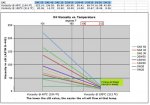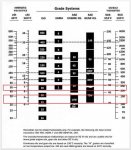Csm Davis
Well-known member
- 4,151
- 376
- 83
- Location
- Hattiesburg, Mississippi
Saw this and wondered what it is? Temperature sensor? Pressure? If so where is the light or gauge?
Steel Soldiers now has a few new forums, read more about it at: New Munitions Forums!

There are lots of variables, but the rule of thumb is not to exceed 180 degrees F. However, the maximum temperature can be quite a bit lower lower if you have a low viscosity hyd oil. The lower viscosity is what hurts the wear parts in hydraulic pumps & motors, but high temperatures shorten the life of every component including hoses. Some of the pumps we used on drill rigs cost almost $10,000, so we paid attention.So my next question is how hot is to hot?
Infrared heat guns have become really inexpensive, I got one at Costco for about $40.00. It would be worth checking out what the temperature actually is. If it is anything over 200, it is bad news. The variables with the biggest impact on what the maximum safe temperature for a hydraulic system are the types of hydraulic pumps and/or motors are in the system and what type of oil. My understanding is that the military ran motor oil in hydraulic systems and Allison transmissions to simplify supply problems and were willing to accept lower lifetimes from the equipment.These trucks get the oil hot really fast and I would guess over 250 in 15 minutes and that is on the 10wt in them.


My thoughts exactly. Penty of 24 v. sources up under the boom. Just need to drill and tap that end fitting. Note to self, " Add to project list for m936".The m939 with the nhc 250 use the same part number for the tranny temp sensor and also for the coolant but different gauges. The sender appears to be the standard one used on most mv's. I would think the resistance is different for both gauges so it reads accurately.
The gauge looks like the standard trans temp one on the M939
Looks like a nice addition especially under sustained use.
Check your last posting in the other thread.Where is location of the transmission sending unit on the m939?
Sent from my SM-G950U using Tapatalk
We get it, advertisements are annoying!
Sure, ad-blocking software does a great job at blocking ads, but it also blocks useful features of our website like our supporting vendors. Their ads help keep Steel Soldiers going. Please consider disabling your ad blockers for the site. Thanks!


